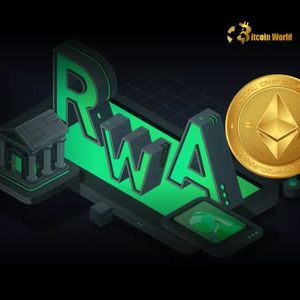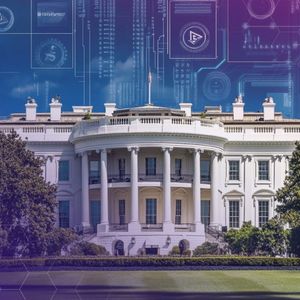RWA Tokenization Explodes Over 260%: Unlocking Massive Growth in Real World Assets
6 min read
BitcoinWorld RWA Tokenization Explodes Over 260%: Unlocking Massive Growth in Real World Assets The convergence of traditional finance and decentralized technology is creating seismic shifts, and nowhere is this more evident than in the burgeoning world of Real World Assets (RWA) tokenization. This sector is not just growing; it’s exploding, demonstrating a phenomenal surge that demands attention from anyone watching the evolution of finance and the Crypto Market . What is RWA Tokenization and Why the Buzz? At its core, RWA Tokenization is the process of putting ownership rights of physical or intangible assets onto a blockchain. Think of anything from real estate, fine art, and commodities to private credit, stocks, and even carbon credits. By representing these Real World Assets as digital tokens, we unlock a new paradigm of liquidity, accessibility, and efficiency. The current buzz isn’t just theoretical; it’s backed by significant market movement. This transformation isn’t just digitizing assets; it’s fundamentally changing how value is transferred, owned, and managed globally. The ability to trade fractions of high-value assets or automate complex financial processes via smart contracts is a game-changer. The Phenomenal RWA Tokenization Market Surge: By the Numbers According to a report highlighted by Cointelegraph, citing data from Binance Research, the RWA Tokenization market has witnessed astonishing growth this year. The market capitalization has soared north of 260% year-to-date. Starting the year at approximately $8.6 billion, the market has ballooned to a staggering $23 billion currently. This isn’t just growth; it’s a rapid acceleration indicating strong demand and increasing adoption. Here’s a quick look at the impressive numbers: Start of Year Market Cap: ~$8.6 billion Current Market Cap: ~$23 billion Year-to-Date Growth: Over 260% Source: Binance Research (as cited by Cointelegraph) This rapid expansion underscores the increasing confidence and participation from various players in the ecosystem, from crypto-native platforms to traditional financial institutions exploring the potential of Tokenized Assets . What’s Fueling the Real World Assets Boom? Several factors are contributing to this remarkable surge in Real World Assets tokenization. Binance Research specifically pointed to two major drivers: Tokenized Private Credit: This involves putting private debt obligations onto the blockchain, making them potentially more accessible and tradeable. It offers alternative financing options for businesses and new investment opportunities for individuals and institutions. Tokenized U.S. Treasury Debt: Representing highly liquid and stable assets like U.S. Treasuries as tokens provides a bridge between traditional safe-haven investments and the blockchain ecosystem. This allows for easier integration into decentralized finance (DeFi) protocols and potentially lower transaction costs and faster settlement times compared to traditional markets. Beyond these specific examples, the broader appeal lies in solving inherent inefficiencies in traditional asset markets, such as illiquidity, high transaction fees, and slow settlement times. Blockchain technology offers a pathway to overcome these hurdles, making a wider range of assets more accessible to a global pool of investors. Unlocking Value: What are the Benefits of Tokenized Assets? The appeal of Tokenized Assets extends across various dimensions, offering compelling advantages for both asset owners and investors: Increased Liquidity: Traditionally illiquid assets like real estate or fine art can become easily tradeable by being broken down into smaller, tokenized units. Fractional Ownership: High-value assets can be owned by multiple individuals, lowering the barrier to entry for investors who might not be able to afford the entire asset. Enhanced Transparency: Transactions are recorded on a public or permissioned blockchain, providing a clear and immutable history of ownership and transfers. Greater Efficiency: Smart contracts can automate processes like dividend distribution, rent collection, or royalty payments, reducing administrative overhead. Accessibility: Global investors can potentially access asset classes previously limited by geographical boundaries or accreditation requirements. Reduced Costs: By cutting out intermediaries, tokenization can lower transaction fees and administrative costs associated with asset management and transfer. 24/7 Trading: Unlike traditional markets with limited hours, tokenized assets can potentially be traded around the clock on blockchain-based platforms. Navigating the Path: What Challenges Does RWA Tokenization Face? Despite the explosive growth, the RWA Tokenization space is not without its hurdles. Addressing these challenges is crucial for sustained, widespread adoption: Regulatory Uncertainty: Clear legal and regulatory frameworks for tokenized assets are still developing in many jurisdictions. This ambiguity can create compliance challenges and deter institutional participation. Legal Frameworks: Ensuring that the digital token legally represents ownership or rights to the underlying physical asset requires robust legal structures and agreements. Valuation and Oracles: Accurately valuing physical assets and securely bringing that real-world data onto the blockchain (via oracles) can be complex. Custody and Security: Securely storing both the digital tokens and managing the underlying physical asset presents unique custody challenges. Interoperability: Ensuring different tokenization platforms and blockchains can interact seamlessly is important for a truly liquid global market. Market Adoption and Education: Widespread understanding and trust from traditional investors and the public are still needed. Smart Contract Risks: Bugs or vulnerabilities in the smart contracts governing the tokens can pose significant risks. Examples in Action: Where is RWA Tokenization Happening? While private credit and US Treasuries are highlighted drivers, Real World Assets tokenization is being explored or implemented across a diverse range of sectors: Real Estate: Tokenizing properties to allow for fractional ownership and easier investment in global real estate markets. Equities and Bonds: Creating digital representations of traditional stocks and bonds for faster settlement and potentially lower costs. Commodities: Tokenizing assets like gold, silver, or oil to make them more accessible and divisible. Art and Collectibles: Enabling fractional ownership of high-value art pieces, rare wines, or other collectibles. Intellectual Property: Exploring ways to tokenize royalties or ownership stakes in patents, music, or other IP. These examples showcase the versatility of Tokenized Assets and their potential to disrupt traditional asset markets. The Future of RWA Tokenization: Regulation and Institutional Adoption The path forward for RWA Tokenization appears promising, heavily influenced by two key factors: regulatory clarity and institutional adoption. As Binance highlighted, clearer regulatory frameworks are expected to pave the way for continued growth and increased participation from major industry players. Large financial institutions, banks, and asset managers are actively exploring or piloting tokenization initiatives. Their entry can bring significant capital, expertise, and credibility to the space. Regulatory bodies are also increasingly engaging with the concept, a necessary step towards creating a secure and compliant environment for tokenized markets to thrive. The integration of Real World Assets into the Crypto Market and DeFi ecosystem is creating powerful new synergies, offering yield opportunities backed by tangible assets and increasing the overall stability and utility of decentralized finance. Actionable Insights for the Reader For those interested in this booming sector: Educate Yourself: Understand the specific assets being tokenized and the platforms facilitating it. Assess Risk: Like any investment, tokenized assets carry risks, including market volatility, regulatory changes, and platform-specific risks. Look for Reputable Platforms: Research platforms that adhere to relevant regulations and have robust security measures. Stay Updated on Regulations: Keep an eye on how regulators in your jurisdiction are approaching tokenized assets. Conclusion: The Unstoppable Rise of Tokenized Real World Assets The more than 260% surge in the RWA Tokenization market this year is a clear indicator that this is far more than just a niche trend; it’s a fundamental evolution in how we perceive, own, and trade assets. Fueled by the tokenization of significant asset classes like private credit and U.S. Treasuries, and underpinned by the inherent benefits of blockchain technology, the market for Real World Assets on-chain is set for continued expansion. While challenges remain, particularly concerning regulation and infrastructure, the momentum is undeniable. As frameworks mature and institutions increasingly participate, Tokenized Assets are poised to become a cornerstone of the future financial landscape, bridging the gap between traditional finance and the decentralized world and unlocking massive value globally. To learn more about the latest crypto market trends, explore our article on key developments shaping Real World Assets tokenization . This post RWA Tokenization Explodes Over 260%: Unlocking Massive Growth in Real World Assets first appeared on BitcoinWorld and is written by Editorial Team

Source: Bitcoin World



